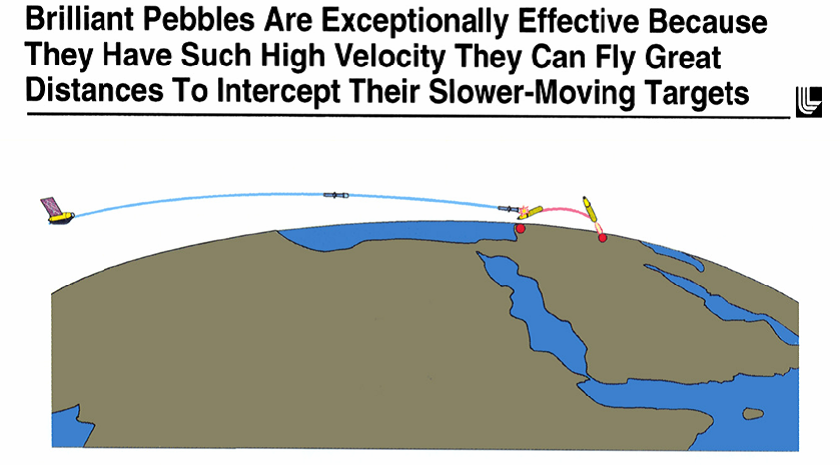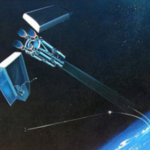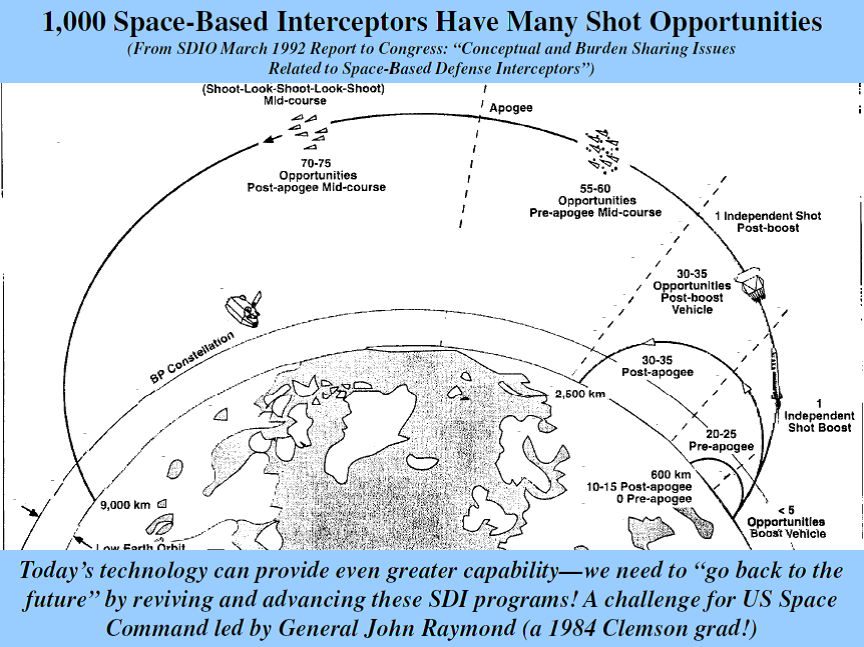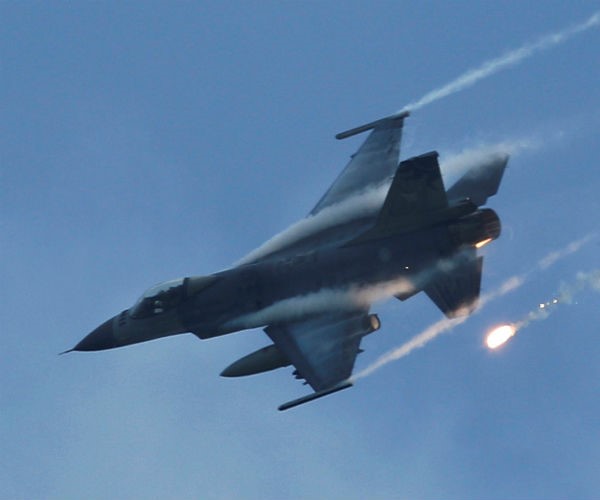“Although the program was cancelled due to opposition in Congress, and lack of interest during the Clinton Administration, the aerospace technology developed utilized a combination of essentially off-the-shelf commercial and military technology that is still available to U.S. aerospace development.” ~ Donald H. Baucom, The Rise and Fall of Brilliant Pebbles, 2004
Click here for the 2004 publication of this important article by Dr. Don Baucom, the independent historian for ballistic missile defense (BMD) programs during my watch during the George H.W. Bush administration as the Director of President Ronald Reagan’s Strategic Defense Initiative (SDI) and my successor during the Bill Clinton administration, Retired Lt. General Mal O’Neill who was also my Deputy SDI Director. Baucom had previously presented it at a September 23, 2001 International Flight Symposium Sponsored by the North Carolina First Flight Centennial Commission, “They Taught the World to Fly: The Wright Brothers and the Age of Flight.”
Retired USAF Colonel Baucom began this important history by quoting from Harold N. Beveridge’s 1960 Advanced Research Projects Agency (ARPA) report for the Director of Defense Research and Engineering on “Project Defender,” that was focused on the prospects for Ballistic Missile Defense Programs of that era:
“A ballistic missile is more vulnerable in its propulsion or boost phase than in any subsequent part of its trajectory. At the same time, its identity is most difficult to conceal. These circumstances immediately suggest an early intercept system as an ideal solution to the defense problem. Unfortunately, enemy missiles are relatively inaccessible during this phase. So far, the only promising defense system concept has been a space based or satellite borne interceptor. Such a system requires many thousands of interceptors in space, but at a given instant only a small fraction will be in a position to attack. The economic feasibility of such systems is heavily dependent upon equipment reliability and upon enemy countermeasures.” (Emphasis added.)
Baucom went on to note that the economic feasibility of such a system has to be borne in mind, and to discuss how that issue surfaced prominently in the history of Brilliant Pebbles (BP), a space-based, kinetic kill interceptor that emerged in the SDI program. Indeed as his history elaborated, during its brief life span,
“Brilliant Pebbles became the central element of the SDI program. From their orbits around the earth, BP interceptors were to be capable of destroying Soviet ICBMs during their boost phase, eliminating their multiple warheads and decoys before these could be dispersed. In this way, a single Brilliant Pebbles interceptor could destroy as many as ten Soviet warheads. This pivotal role makes the BP story crucial to the broader history of the SDI program.”
Moreover, I would now add to Don’s brief introduction that the BP story is important today because no subsequent administration of either party has sought to revive any aspect of that important program. Indeed, as viewed by the first four directors of what is today called the Missile Defense Agency (MDA), Brilliant Pebbles was the most important BMD concept that emerged from the SDI era (1983-1993). Baucom’s history should be required reading for all who want to understand how and why BP fell from favor, at least to avoid a repeat performance as the “powers that be” consider the possibilities for President Trump’s Space Force.
Below is a Lawrence Livermore National Laboratory (LLNL) figure illustrating a fundamental BP feature — namely that once they are deployed in space, their orbital velocity provides enormous reach to attack far away ballistic missiles — and depending on the range of those threatening ballistic missiles, that intercept can take place at various points in their threatening trajectories.
 In particular, a BP system could intercept North Korean ballistic missiles beginning in their boost phase and throughout their further flight until shortly after they begin their reentry into the atmosphere over the United States. Over a hundred independent intercept opportunities would be provided, as was reported and illustrated in Figure 6 from page 20 of a March 1992 Strategic Defense Initiative (SDI) Report to Congress — inserted below. This now completely open source report is worth reading if you wish to understand the concepts we were pursuing 30 years ago.
In particular, a BP system could intercept North Korean ballistic missiles beginning in their boost phase and throughout their further flight until shortly after they begin their reentry into the atmosphere over the United States. Over a hundred independent intercept opportunities would be provided, as was reported and illustrated in Figure 6 from page 20 of a March 1992 Strategic Defense Initiative (SDI) Report to Congress — inserted below. This now completely open source report is worth reading if you wish to understand the concepts we were pursuing 30 years ago.
Click here for links to my previous messages on Brilliant Pebbles, an important effort that recent events signal could be revived by President Donald Trump in the context of his oft-stated interest in a “Space Force, separate from and equal to the Air Force.”
Recent events improve the potential for such a BP revival. Congressional support at least seems to be growing, as illustrated by the John S. McCain National Defense Authorization Act for 2019 (NDAA-2019) now passed by both the House and Senate and discussed in my two most recent Newsmax articles. Click here for the first which was the focus of my High Frontier message last week. Note the important congressional initiative directing the Pentagon to report back to congress within a year with a definitive plan to build a space based interceptor system.
Click here for the second Newsmax article, repeated below. In this second article, I emphasize the first important point in Don Baucom’s BP history, on the importance of achieving a boost-phase intercept (BPI) capability, against threatening missiles as their rockets burn to lift them from their launchers. And I emphasize that in the near-term air-based BMD systems flying near given threat ballistic missile launch sites can provide BPI opportunities against North Korea’s existing ballistic missiles — and later BP can provide a global BPI capability.
US Must Still Be Ready to Intercept North Korea’s Missiles
An F-16 during exercises. (AP/Wally Santana)
By Henry F. Cooper /Newsmax/Thursday, 02 August 2018 04:49 https://www.newsmax.com/henryfcooper/jong-un-bdaa-reagan-sbi/2018/08/02/id/875225/
The juxtaposition of two important recent events herald the importance of a new ballistic missile defense (BMD) initiative to build as quickly as possible a capability to intercept attacking missiles in their boost phase, while they are most vulnerable as their rockets burn to lift them from their launchers:
- Recent reports that North Korea continues to build threatening ballistic missiles —raising international doubts about Kim Jong Un’s alleged commitment to his agreements with President Trump at their recent summit; and
- Wednesday’s overwhelming U.S. Senate vote (87-to-10) approving the John S. McCain National Defense Authorization Act for 2019 (NDAA-2019), with the anticipated President’s Signature, to become the law of the land.
By pressing ahead rapidly with the second, we can provide important leverage to support President Trump’s efforts to reach agreement with Kim Jong Un to end North Korea’s nuclear and ballistic missile programs.
Note: Our intelligence community has estimated North Korea already has up to 60 nuclear weapons and has demonstrated an ability to use its existing ballistic missiles to reach any American city — once they have an ability to reenter the atmosphere.
Moreover, they already could easily detonate a single nuclear weapon in space over the United States, using satellites like those they demonstrated years ago.
The resulting electromagnetic pulse (EMP) could take down indefinitely our critical infrastructure, particularly our vulnerable electric power grid. According to the recent Congressional EMP Commission, the resulting loss of electricity could lead to the death of most Americans within months due to starvation, disease and societal collapse.
Thus, working to protect against this truly existential threat deserves a very high national priority. Happily, the NDAA-2019 provides Congressional initiatives supporting programs to do so—about which I have recently written.
In particular, among the details of this $717 billion NDAA-2018 (summarized by the Chairman of the House Armed Services Committee) is a directive that requires the director of the Missile Defense Agency (MDA) to, “establish a boost phase intercept program using kinetic interceptors, initiate development of a missile defense tracking and discrimination space sensor layer, and continue efforts to develop high power directed energy for missile defense applications.”
A boost phase intercept (BPI) capability can be provided quickly with existing operational aircraft and improved a few years later with High Altitude Long Enduring (HALE) Unmanned Aerial Vehicles (UAVs) and eventually by a global space-based intercept (SBI) capability, also mandated in the NDAA 2019 as discussed earlier this week.
Consider our near-term options. Almost a year ago, my August 28, 2017 Newsmax article proposed, in two stages, that:
- For this BPI mission, we immediately exploit the existing Advanced Medium-Range Air-to-Air Missile (AMRAAM), used by fighter aircraft deployed by the U.S. Air Force, U.S. Navy and 25 allied nations to attack other aircraft. They can be rapidly modified to enable fighter aircraft to accomplish the BPI mission, provided they fly sufficiently near the North Korean launch site.
- Shortly thereafter, we can and should deploy defenses that can be launched from high-altitude long-enduring (HALE) unmanned aerial vehicles (UAVs), as also has been discussed previously. General Atomics’ Reaper HALE system can rapidly be empowered (within a year?) to enable this capability against North Korea.
These systems are well developed and battle seasoned. They should be empowered immediately in a highly demonstrated way to impress Kim Jong Un.
In addition, our widely deployed Aegis BMD ships can be brought into play rapidly to counter North Korean ballistic missiles. While they cannot perform a BPI mission, nearby Aegis BMD ships can intercept North Korean ballistic missiles as they rise above the atmosphere and more distant Aegis BMD ships can intercept the descending North Korean missiles as they approach the United States.
The crews simply need to be trained and ready to accomplish this mission, as was discussed in some detail last September 8.
Finally, as discussed earlier this week, I applaud the NDAA-2019 direction that the Pentagon provides a plan for building a space-based intercept (SBI) system. Thirty years ago, we understood how to do this, but have been blocked by political, not technical impedance.
Such a system could intercept North Korean ballistic missiles beginning in their boost phase and throughout their further flight until after they begin their reentry into the atmosphere over the United States. Over a hundred independent intercept opportunities would be provided, as was reported and illustrated in Figure 6 from page 20 of a March 1992 Strategic Defense Initiative (SDI) Report to Congress.
This now publically available report provides a window into the global defense concepts and capabilities we were seeking 30 years ago — and should more than suggest that we can “Go back to the future!” to reach President Ronald Reagan’s SDI vision.
The NDAA-2019 couples well with President Trump’s instructions to the Pentagon to come up with plans for a Space Force, separate from and equal to the Air Force.
In any case, Congress and the White House agree that we should move out to provide an ability to intercept North Korea’s capability to attack the U.S. with their ballistic missiles, if Kim Jong Un decides to continue developing them.
Indeed, a crash program to provide air- and space-based boost phase intercept capabilities also would add to President Trump’s negotiating leverage to persuade Kim Jong Un to end his ballistic missile and nuclear weapons programs.
Stay tuned!
I also urge the Pentagon to follow the original BP pattern and accelerate efforts to build as soon as possible space-based interceptors (SBIs) employing today’s commercially available technology, the basic approach followed by LLNL 30-years ago. Today’s technology should enable a less expensive system than the Pentagon’s independent cost estimators then gave for development, testing, deployment and operations for 20-years — $20-billion in today’s dollars.
I would emphasize that new effort should also follow the BP program management plan and revive a Brilliant Pebbles Task Force with the same dedication to that objective as the original one. A BP Task Force, reporting directly to the SDI Director was then necessary, because the Air Force resisted adapting its approach to exploit innovative ideas then advocated by LLNL’s physicists and engineers, who conceived and pioneered the BP effort.
Perhaps the Pentagon, under directives from Undersecretary of Defense for Research and Engineering Mike Griffin, will be more innovative, but I can attest that the acquisition and services (including the Air Force) bureaucracy during my watch constituted a major impedance against innovation.
As the Pentagon plans unfold for the President’s Space Force initiative, those new conditions may help. But recent reports suggest that the Pentagon’s proposed response to the President’s Space Force initiative will be to recommend forming a new Space Command (or a Space Corps) within the Air Force. For example, click here for yesterday’s related Defense News report, which also summarizes Pentagon leadership opposition to President Trump’s Space Force initiative.
Thus — in any case, I would argue for again reviving a competent and independent Brilliant Pebbles Task Force reporting directly to the Director of the Missile Defense Agency (MDA), USAF LGen. Samuel Greaves. I believe that step would better aid an effort by Dr. Griffin to revive Brilliant Pebbles, an objective I believe he will strongly support.
After all, as my Deputy for Technology nearly 30 years ago he did; and his previous contributions at the Applied Physics Laboratory and in supporting all MDA Directors have added immeasurably to my confidence that, with President Trump’s interest and Dr. Griffin’s support, General Greaves and his MDA team can indeed revive the rapid development of a modern Brilliant Pebbles.
Bottom Lines.
Congressional initiatives strongly support the timely development of boost-phase intercept capabilities, based initially on aircraft and, as soon as possible, in space.
By working constructively toward such operational capabilities under these congressional directives, the Pentagon can “kick start” President Trump’s Space Force with a streamlined management appropach — and by the end of his second term help dominate space as is his stated objective.
Stay tuned for Pentagon reports to congress on its Missile Defense Review and its game plan for a Space Force.
What can you do?
Join us in praying for our nation, and for a rebirth of the freedom sought, achieved and passed to us by those who came before us.
Help us to spread our message to the grass roots and to encourage all “powers that be” to provide for the common defense as they are sworn to do.
Begin by passing this message to your friends and suggest they visit our webpage www.highfrontier.org, for more information. Also, please encourage your sphere of influence to sign up for our weekly e-newsletter.
Encourage them to review our past email messages, posted on www.highfrontier.org, to learn about many details related to the existential manmade and natural EMP threats and how we can protect America against them. I hope you will help us with our urgently needed efforts, which I will be discussing in future messages.
Click here to make a tax deductible gift. If you prefer to mail a check, Please send it High Frontier, 20 F Street 7th Floor, Washington, DC 20001.
E-Mail Message 180807
Please click here to read Past Weekly Updates!
Please help High Frontier continue this important and timely work!
Be sure to follow us on our Social Sites!
If you found this letter via our Social Sites, and you would like to subscribe, please click below!







